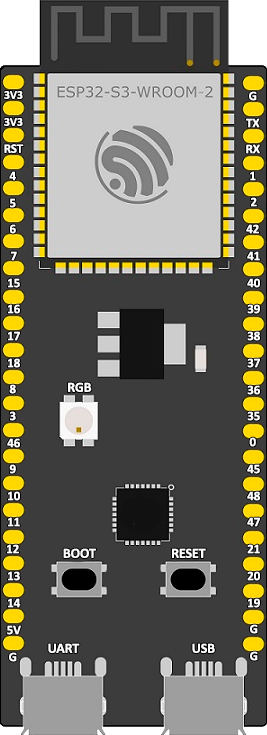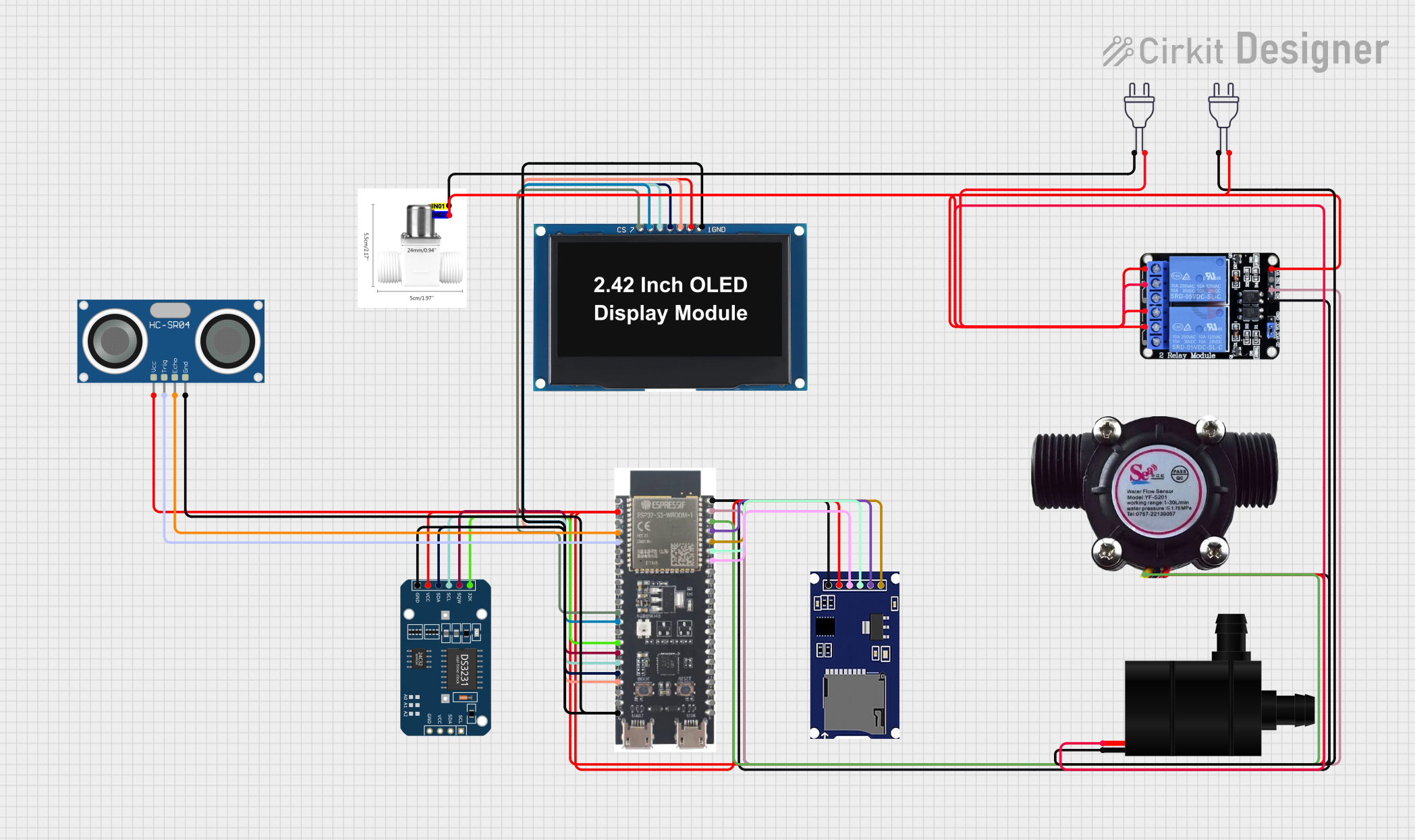
How to Use Esp32s3: Examples, Pinouts, and Specs

 Design with Esp32s3 in Cirkit Designer
Design with Esp32s3 in Cirkit DesignerIntroduction
The ESP32-S3 is a low-power system on a chip (SoC) developed by Espressif. It is designed for Internet of Things (IoT) applications, offering integrated Wi-Fi and Bluetooth Low Energy (BLE) capabilities. The ESP32-S3 features a dual-core Xtensa LX7 processor, enhanced AI acceleration, and a wide range of peripherals, making it ideal for applications such as smart home devices, wearables, industrial automation, and more.
The ESP32-S3-DevKitC-1 is a development board based on the ESP32-S3 SoC, providing an easy-to-use platform for prototyping and development. It includes onboard USB-to-serial functionality, GPIO pins, and support for external peripherals.
Explore Projects Built with Esp32s3

 Open Project in Cirkit Designer
Open Project in Cirkit Designer
 Open Project in Cirkit Designer
Open Project in Cirkit Designer
 Open Project in Cirkit Designer
Open Project in Cirkit Designer
 Open Project in Cirkit Designer
Open Project in Cirkit DesignerExplore Projects Built with Esp32s3

 Open Project in Cirkit Designer
Open Project in Cirkit Designer
 Open Project in Cirkit Designer
Open Project in Cirkit Designer
 Open Project in Cirkit Designer
Open Project in Cirkit Designer
 Open Project in Cirkit Designer
Open Project in Cirkit DesignerCommon Applications
- Smart home devices (e.g., smart lights, thermostats)
- Wearable electronics
- Industrial IoT systems
- AI and machine learning applications
- Wireless sensor networks
- Robotics and automation
Technical Specifications
Key Technical Details
| Parameter | Value |
|---|---|
| Manufacturer | Espressif |
| Part Number | ESP32-S3-DevKitC-1 |
| Processor | Dual-core Xtensa LX7 |
| Clock Speed | Up to 240 MHz |
| Flash Memory | 4 MB (default, varies by model) |
| RAM | 512 KB SRAM + 8 MB PSRAM (optional) |
| Wireless Connectivity | Wi-Fi 802.11 b/g/n (2.4 GHz), Bluetooth 5.0 LE |
| AI Acceleration | Vector instructions for AI/ML workloads |
| GPIO Pins | 45 (including ADC, DAC, I2C, SPI, UART, PWM, etc.) |
| Operating Voltage | 3.3 V |
| Power Supply | USB 5 V or external 3.3 V |
| Operating Temperature | -40°C to +85°C |
| Dimensions | 54 mm x 25.5 mm |
Pin Configuration and Descriptions
The ESP32-S3-DevKitC-1 features a 2x19 pin header layout. Below is a summary of the key pins:
| Pin Name | Function | Description |
|---|---|---|
| 3V3 | Power | 3.3 V power supply |
| GND | Ground | Ground connection |
| EN | Enable | Chip enable (active high) |
| IO0 | GPIO0 | General-purpose I/O, boot mode selection |
| IO1-IO45 | GPIO1 to GPIO45 | General-purpose I/O pins with multiple functions |
| ADC1/ADC2 | Analog-to-Digital Converter | 12-bit ADC channels |
| DAC1/DAC2 | Digital-to-Analog Converter | 8-bit DAC channels |
| TXD/RXD | UART TX/RX | UART communication pins |
| SCL/SDA | I2C Clock/Data | I2C communication pins |
| MOSI/MISO | SPI Data In/Out | SPI communication pins |
| PWM | Pulse Width Modulation | PWM output for motor control, LEDs, etc. |
Usage Instructions
How to Use the ESP32-S3 in a Circuit
Powering the Board:
- Connect the ESP32-S3-DevKitC-1 to your computer via a USB-C cable for power and programming.
- Alternatively, supply 3.3 V to the 3V3 pin and connect GND to ground.
Programming the Board:
- Install the Arduino IDE or Espressif's ESP-IDF (Espressif IoT Development Framework).
- Add the ESP32 board support package to the Arduino IDE via the Board Manager.
- Select "ESP32-S3-DevKitC-1" as the target board.
Connecting Peripherals:
- Use the GPIO pins to connect sensors, actuators, or other peripherals.
- Ensure that the voltage levels of connected devices are compatible with the ESP32-S3's 3.3 V logic.
Uploading Code:
- Write your code in the Arduino IDE or ESP-IDF.
- Connect the board to your computer and select the correct COM port.
- Click "Upload" to flash the code to the ESP32-S3.
Example Code: Blinking an LED
Below is an example of how to blink an LED connected to GPIO2 using the Arduino IDE:
// Define the GPIO pin for the LED
#define LED_PIN 2
void setup() {
// Set the LED pin as an output
pinMode(LED_PIN, OUTPUT);
}
void loop() {
// Turn the LED on
digitalWrite(LED_PIN, HIGH);
delay(1000); // Wait for 1 second
// Turn the LED off
digitalWrite(LED_PIN, LOW);
delay(1000); // Wait for 1 second
}
Important Considerations
- Voltage Levels: Ensure all connected peripherals operate at 3.3 V logic levels. Use level shifters if necessary.
- Boot Mode: GPIO0 must be pulled low during boot to enter programming mode.
- Power Supply: Use a stable power source to avoid unexpected resets or malfunctions.
Troubleshooting and FAQs
Common Issues
Board Not Detected by Computer:
- Ensure the USB cable is functional and supports data transfer.
- Install the required USB-to-serial drivers for the ESP32-S3.
Code Upload Fails:
- Check that GPIO0 is pulled low during programming.
- Verify the correct COM port and board are selected in the IDE.
- Ensure no other application is using the COM port.
Wi-Fi Connection Issues:
- Verify the SSID and password in your code.
- Ensure the Wi-Fi network operates on the 2.4 GHz band (not 5 GHz).
Random Resets or Instability:
- Check the power supply for sufficient current (at least 500 mA).
- Avoid floating input pins by using pull-up or pull-down resistors.
FAQs
Q: Can the ESP32-S3 run AI/ML models?
A: Yes, the ESP32-S3 includes vector instructions optimized for AI/ML workloads, making it suitable for lightweight AI applications.
Q: How do I reset the board?
A: Press the "EN" button on the board to reset the ESP32-S3.
Q: Can I use the ESP32-S3 with Python?
A: Yes, the ESP32-S3 supports MicroPython, allowing you to program it using Python.
Q: What is the maximum Wi-Fi range?
A: The Wi-Fi range depends on environmental factors but typically reaches up to 100 meters in open spaces.
This concludes the documentation for the ESP32-S3-DevKitC-1. For further details, refer to the official Espressif documentation.